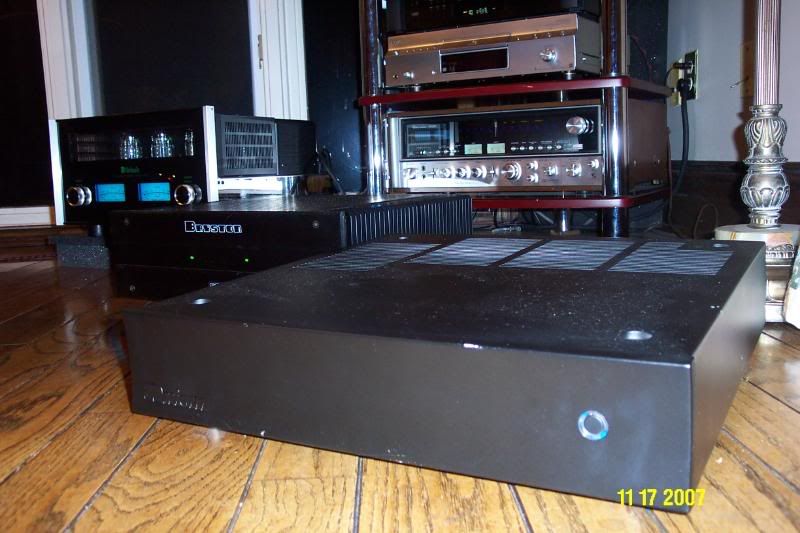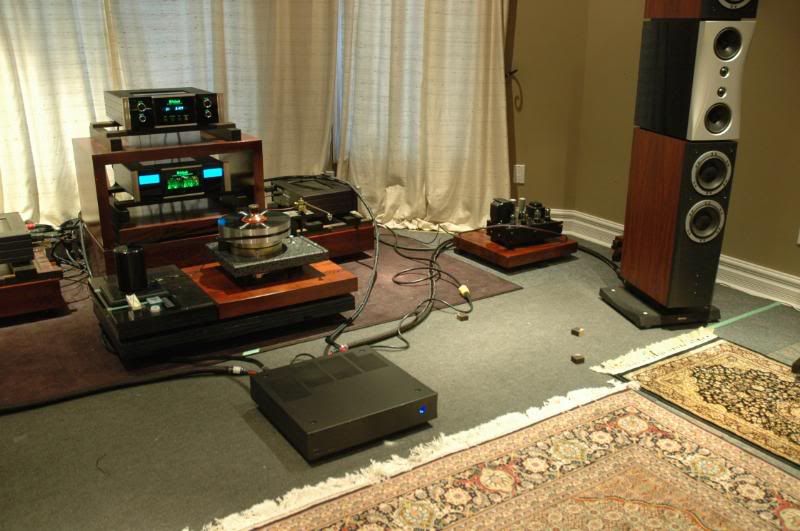Before getting into my views on why and how let me say right at the outset that this is one killer amp. I love amps and have owned many over the years and as I'm reminded from time to time have more than a few around the house.
One thing I'd like to get off my chest is this notion which is expressed far too often around here that a small power supply ie. as found in most receivers is all you really need to produce quality sound. I've posted my views on this perspective which IMO quite frankly is just plain disinformation. (I edited out another word I had for "disinformation"

) In general, I agree that the more efficient your speakers are, the smaller your room, the closer you sit to the speakers, or the lower volumes you listen to then the less power that you will need. However what I am concerned about is high quality sound and if that is the overriding objective there is no getting around having large reserves of power on standby in order to
reproduce peaks cleanly and avoid any nasties from clipping.
How much power is enough you ask? Much more than you think you need is my succinct answer. Let's take a look at some real life situations to put that into perspective so you can appreciate why our good friends at Axiom have devoted such effort and expense to developing the A1400-8.
Generally speaking in most rooms, most amps are not played beyond a few watts nominal at moderate listening levels. It is at peaks such as from loud transients that more power is demanded by the speaker. At higher listening levels which can easily occur on recordings with good dynamic range power amps can clip without a lot of power bandwidth in reserve. The key concept here is that a doubling of wattage is necessary for every 3db increase. So, if the speaker like the M80 is around 91db efficient at one watt, you hear around 81db at 4 metres away, whether your amp is rated at ten watts or 200 or 1400 watts. Now what happens if you play a classical piece with great dynamic range, typically where the dynamic peaks are 15db higher than that 90db average listening level, you require 32 watts above the average power required for that. Even with rock music which typically has lower dynamic range becasue of the hih compression used during recordings, the need for extra power remains since most rock/jazz fans enjoy listening at higher overall levels compared to classical music.
Now let's say you enjoy raising the volume up by say 8 watts when playing a good tune. Then to handle a 15db peak, you would require and additional 256 watts to handle it. If you had a 18db peak , you'd need 512 watts. This all assumes that the amp was fast enough to respond to these increased power demand otherwise you would get slew induced distortion which can be just as annoying as clipping distortion. Also keep in mind that the above example assumes a constant impedance. However the impedance of the speaker load is always changing so power demands will also be affected by such impedance swings. The other thing to keep in mind is that in many amps much of the energy is disippiated as heat so many of the watts produced are "lost". Also its important to note that the power demands of the speaker are rarely linear like in my simplified example which is another reason for a fast high power supply.
Ok I got that off my chest.

So please don't post any comments like... gee I love my receiver and I don't see how a powerful fast separate amp like the a1400-8 can improve my sound.
After hearing and reading so much about the supposed attributes of this "uber" amp I have to admit to getting my usual feeling of healthy scepticism. You know, how it replaces a stack of monoblocs, just like the Bryston 7BSSTs except faster, dynamic power handling, how its able to allocate more power to whatever channel demands more. Is this the amp that can leap tall buildings in a single bound? So after many questions and hearing how good it was from a Floridian friend of mine who bought one, I finally was given one of the lab amps to audition six weeks ago. As it turns out Axiom can only produce two a day of these high quality hand-made amps so I patiently waited for one to become available.
Rather than install it into my HT where it is now, I spent several weeks with it in my stereo rig and went back and forth with by Bryston 4BSSTs and a tube McIntosh c2102 for good measure.

My initial impression when I added the a1400-8 and disconnected the 4bsst was that the amp had taken over my system. Everything sounded...well...effortless. The highs were more transparent and the bass seemed tighter. I also noticed I had to turn down the volume on my preamp because of the higher gain. The Axiom amp also never seemed to get warm to the touch meaning it was very efficient at not losing energy in the form of heat. My woofers seemed to be vibrating visibly faster. There also seemed to be more texture and detail to the sound. When I reinstalled the Bryston everything seemed a tad softer and the bass less tight which was very surprising seeing how the 4bsst delivers 500wpc at 4 ohms. The playing field got balanced when I added a second Bryston 4BSST and bridged each one in mono mode so in effect each Bryston was delivering 1000w per channel into each speaker. It seemed I had found an equivalent setup sonically: one a1400-8 or 2 Bryston 4BSSTs. Arguably the Bryston pair was more powerful seeing how the the 1400-8 was supposedly delivering 700wpc but a later conversation with Tom Cumberland clarified that view ie. if called upon the 1400-8 could deliver more output into each channel and indeed more than 1400watts, and perhaps more importantly the Axiom amp was indeed faster than the Brystons. The slew rate of the A1400-8 is estimated at >80V/microsec while the slew rate on the Bryston SST amp is closer to >60V/microsec. While that may not read like much it does translate into a much faster reponse time when power is required by say a loud bass peak. Net result: tighter bass and clearer highs. However to my ear, the two mon-bridged Brystons and the a1400-8 sounded the same. Too bad for me that my Bryston pair costs over twice as much as the Axiom amp.

As November went by I had the opportunity to listen to all sorts of different music and the conclusion above held up no matter if it was classical, jazz
, rock or other genres. I would add rap but I have had a hard time appreciating that music though my kids love to play it on my stereo rig.

To double check my impressions I lent the Axiom amp to a friend of mine for a few days of comparison. A shot of his system appears below. As you can see he is a big fan of McIntsh gear and power hungry Dynaudio speakers.

He too was sceptical that such a light amp could drive his speakers. I enjoyed watching the look on his face when we played a fast moving orchestral piece by Chabrier. He mentioned he had never seen his woofers move so quickly with as much detail. Now to be fair he had just sold his tube amps and this was the first real powerful solid state amp in his system. Still for a classical aficionado like him he was quite impressed with how well the a1400-8 handled the large dynamic swings. In a word he described it as a "superb" fast powerful amp. He way overestimated the cost of the amp by the way.
When I picked up the amp and before installing it in the HT I thought I would see how it compared to my tube McIntosh mc2102which does 100wpc. As expected it didn't have the lush midrange of the tube amp but then again it produced the low frequencies and detailed highs with ease compared to the Mac. Interestingly at high volume even though the Mac was likely clipping, I didn't find the "soft" clipping of the tubes objectionable compared to the clipping of an underpowered solid state amp. Needless to say I have never been able to clip the Axiom amp.
Currently the 1400-8 resides in my HT where it has replaced an Outlaw 770 7 channel amp with 300wpc. Everything seems more open and transparent with DVDs. When I recalibrated I had to lower the speaker levels by 3db. Sound effects and musical scores just seem livelier and more natural. I'll post some more comments and shots later about how it does with HT.




